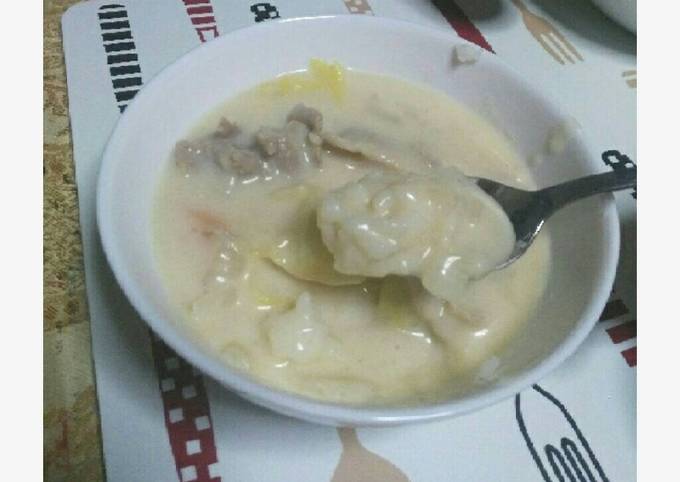Japanese white stew (sauce). Japanese Cream Stew, also known as White Stew, is rich and creamy without being heavy. It's a classic Yoshoku meal packed with tender chicken, bite-size vegetables, and served with steamed rice or crusty bread. As the name suggests, White Stew is a white coloured stew made from béchamel sauce.
 It's a staple at Japanese steakhouse restaurants and some Mongolian BBQ joints, and it. This is a list of Japanese soups and stews. Japanese cuisine is the food—ingredients, preparation and way of eating—of Japan.
It's a staple at Japanese steakhouse restaurants and some Mongolian BBQ joints, and it. This is a list of Japanese soups and stews. Japanese cuisine is the food—ingredients, preparation and way of eating—of Japan.
Hey everyone, hope you are having an incredible day today. Today, I'm gonna show you how to make a special dish, japanese white stew (sauce). One of my favorites food recipes. This time, I'm gonna make it a little bit tasty. This will be really delicious.
Japanese white stew (sauce) is one of the most well liked of current trending foods on earth. It is simple, it is quick, it tastes delicious. It is enjoyed by millions every day. Japanese white stew (sauce) is something that I have loved my entire life. They're nice and they look wonderful.
Japanese Cream Stew, also known as White Stew, is rich and creamy without being heavy. It's a classic Yoshoku meal packed with tender chicken, bite-size vegetables, and served with steamed rice or crusty bread. As the name suggests, White Stew is a white coloured stew made from béchamel sauce.
To begin with this recipe, we must first prepare a few components. You can have japanese white stew (sauce) using 9 ingredients and 9 steps. Here is how you can achieve that.
The ingredients needed to make Japanese white stew (sauce):
- {Take of meat (whatever is fine, here I used pork).
- {Take of potato.
- {Get of carrot.
- {Prepare of onion.
- {Take of chicken bullion pills (avecrem).
- {Get of sauce:.
- {Make ready of flour (4 big spoons).
- {Prepare of butter (around 3 spoons).
- {Take of milk.
The phrase ichijū-sansai (一汁三菜, "one soup, three sides") refers to the makeup of a typical meal served, but has roots in classic kaiseki, honzen, and yūsoku cuisine. A yoshoku (Western-influenced) dish, Japanese white (cream) stew is traditionally cooked with chicken and vegetables in Bechamel sauce thickened with cream. Beef is substituted for the chicken in this recipe. Called "cream stew" or "white stew" this is a typical yōshoku dish: one with ingredients that have European-Western roots, but which is uniquely Japanese.
Steps to make Japanese white stew (sauce):
- Chop the vegetables.
- Boil water in a pot and add the vegetables and the meat.
- Retire the white fat that appears in the surface of the water with a spoon.
- Add two pills of chicken bullion (avecrem) while it's boiling.
- Sauce: melt the butter in a frying pan.
- Add the flour and mix until it looks like a powder.
- Once the potatoes are soft in the pot, add to the fray pan the milk, just a little and mix, then again until it es soft and looks like a dough.
- Then add the dough to the pot and mix slowly (heat low), then if you want it more fluid add more milk (suit your taste) and aderece (salt, pepper...).
- Bon appetit.
While white or bechamel sauce-based dishes existed prior to World War II on the menus of fancy yōshoku, the "white stew" as we know it. White Stew, also known as Cream Stew, is a Japanese-style stew under the category of "Yōshoku" which means Western-influenced cooking which originated during the Meiji Restoration. White Stew is filled with chicken, potatoes, and vegetables and made with béchamel sauce. White soy sauce is lighter in color and flavor than its darker cousins you're probably used to. White soy can be used in anything that the darker stuff would overpower - Delicate sushi and other fish dishes, for instance, but also in soups and stews, veggies, or pasta - It also makes a great vinaigrette.
So that's going to wrap it up for this exceptional food japanese white stew (sauce) recipe. Thanks so much for reading. I am confident that you can make this at home. There's gonna be more interesting food at home recipes coming up. Remember to save this page on your browser, and share it to your loved ones, colleague and friends. Thank you for reading. Go on get cooking!